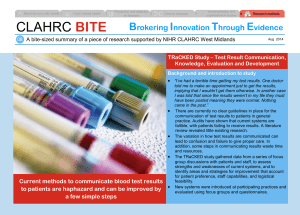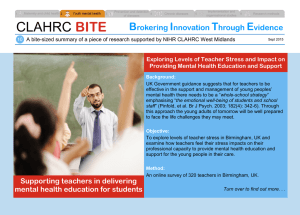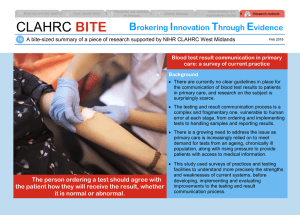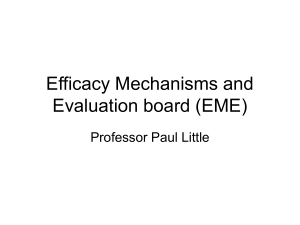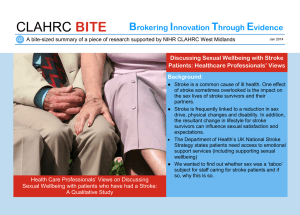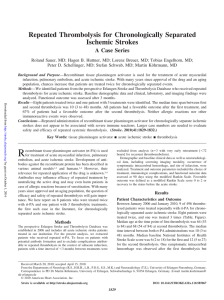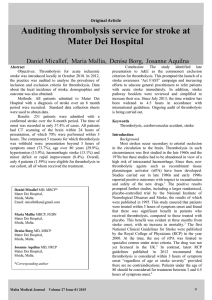CLAHRC BITE B
advertisement
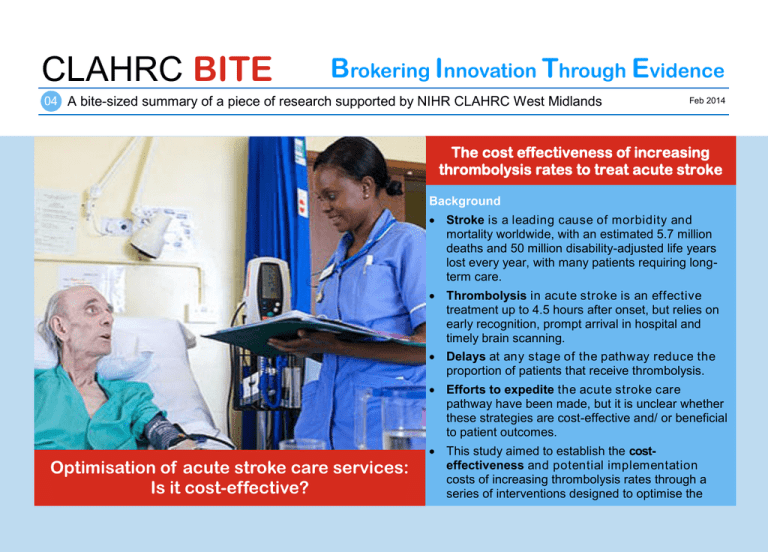
CLAHRC BITE Brokering Innovation Through Evidence 04 A bite-sized summary of a piece of research supported by NIHR CLAHRC West Midlands Feb 2014 The cost effectiveness of increasing thrombolysis rates to treat acute stroke Background Stroke is a leading cause of morbidity and mortality worldwide, with an estimated 5.7 million deaths and 50 million disability-adjusted life years lost every year, with many patients requiring longterm care. Thrombolysis in acute stroke is an effective treatment up to 4.5 hours after onset, but relies on early recognition, prompt arrival in hospital and timely brain scanning. Delays at any stage of the pathway reduce the proportion of patients that receive thrombolysis. Efforts to expedite the acute stroke care pathway have been made, but it is unclear whether these strategies are cost-effective and/ or beneficial to patient outcomes. Optimisation of acute stroke care services: Is it cost-effective? This study aimed to establish the costeffectiveness and potential implementation costs of increasing thrombolysis rates through a series of interventions designed to optimise the Findings: A series of strategies to reduce delay in receiving thrombolysis were analysed for their costeffectiveness by examining the cost of the strategy per quality-adjusted life year (QALY) gained. The strategies included more timely referrals and CT scans, and it was found that all the intervention strategies were cost-effective because of a reduction in dependency after stroke and subsequent reduction in long-term care costs. The largest cost reduction was the strategy of immediate CT scan upon arrival, with a saving of US$75,000 and an additional 5.4 QALYs per 100,000 population The most achievable strategy with the largest potential benefit was that of better recording of stroke symptom onset time. This resulted in 3.3 additional QALYs and a cost saving of US$46,000 per 100,000 population. An enhanced electronic pro forma has been developed for use by all paramedics in the West Midlands Ambulance Service to include ‘time of onset’ in the Face Arm Speech Test (FAST) – an assessment tool used to improve paramedic recognition of suspected stroke to both improve reporting rates and to facilitate more efficient in-hospital care. Reference: Penaloza-Ramos MC, Sheppard JP, Jowett S, et al. Cost effectiveness of optimizing acute stroke care services for thrombolysis. Stroke. 2014; 45: 553-62. [Link]. Recommendations for practice A variety of interventions to increase thrombolysis rates for acute stroke in clinical practice would be cost-effective, and significant investment in implementation could be quickly repaid due to reduced dependency of stroke patients after timely intervention. What is NIHR CLAHRC West Midlands? The Collaborations for Leadership in Applied Health Research and Care (CLAHRC) is a partnership between universities (Birmingham, Warwick and Keele) and a number of health and social care organisations in the West Midlands. We are funded by the National Institute for Health Research with a mission to undertake high-quality applied health research focused on the needs of patients to improve health services locally and beyond. For further information, visit: www.clahrc-wm.nihr.ac.uk The research is funded by the National Institute for Health Research. The views expressed are those of the author and not necessarily those of the NHS, the NIHR or the Department of Health.

